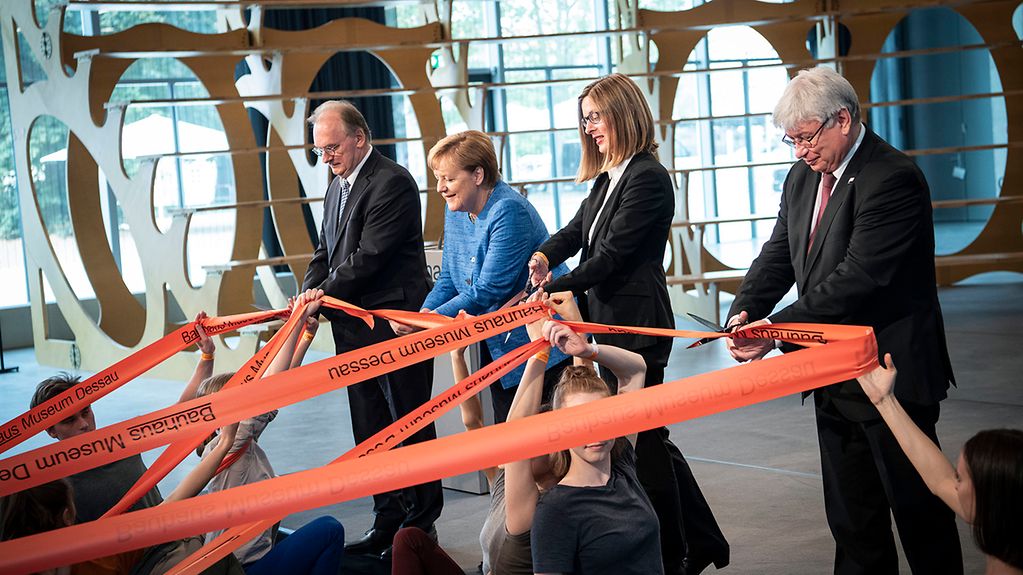Chancellor opens museum in Dessau
Furniture, textiles, lamps and much much more – the collection of the Bauhaus Foundation in Dessau comprises a total of about 49,000 items, which can now be seen in a newly built museum in the heart of Dessau. Chancellor Angela Merkel opened it at a special ceremony on Sunday.
4 min reading time

Chancellor Angela Merkel at the opening of the museum in Dessau - the Bauhaus project has lost none of its fascination
Photo: Bundesregierung/Bergmann
From the narrow confines of its former home on the edge of town to spacious accommodation in the centrally located Stadtpark – behind the dark glass façade of the new Bauhaus Museum in Dessau (Saxony-Anhalt), there is more space not only for the magnificent collection. The cuboid, with over 3,500 square metres of floorspace, also provides new scope for the ideas that were so inherent to Bauhaus: experimenting, testing and discovery.
"We share the need to preserve the diverse legacy of Bauhaus and to communicate the pioneering ideas of the Bauhaus school," said Chancellor Angela Merkel when she opened the new museum in Dessau. Even 100 years on, the Bauhaus project has lost none of its fascination. Bauhaus ideas, Bauhaus architecture, Bauhaus art and design continue to influence the way we build, live and shape our surroundings today.
In her latest video podcast the Chancellor underscored how Bauhaus has moulded the 20th century. "Rethinking the world, re-moulding the world we live in, absorbing impetus from all sorts of different artistic movements."
New intellectual energy field
The official opening was one of the highlights of this year, which marks the one hundredth anniversary of the world-renowned school of design. The federal government put up one half of the 28 million euros needed for the new building. This 14 million euros came from the budget of the Federal Government Commissioner for Culture and the Media, with good reason explained Minister of State Monika Grütters before the opening. "At last we have a setting in which the treasures of the Dessau collection can be presented in their entirety to a national and international audience." The Foundation, she said, has generously proportioned new rooms and the centre of Dessau has a new intellectual energy field.
Weimar and Berlin have also received new buildings, to which the federal government made a major contribution. The Bauhaus Museum in Weimar opened in April 2019, while June 2019 saw the earth breaking ceremony for the Berlin Bauhaus Archive’s new building.
The Bauhaus laboratory
On the ground floor of the new museum in Dessau there is a form for dance, concerts, drama or discussions. It is accessible to everyone during the museum’s opening hours. The upper floor is less a complete floor than a floating black space, also known as the Black Box. From now on a good 1,000 exhibits from the magnificent Bauhaus collection will be shown there in the permanent exhibition "Versuchsstätte Bauhaus (Bauhaus Laboratory) – the Collection".
The actual Bauhaus Dessau, designed by Walter Gropius simply did not offer the space needed for an exhibition on this scale, being only 600 square metres large. The new museum, with 3,500 square metres floorspace offers the space to show for the first time the world’s second largest Bauhaus collection. The collection goes back 50 years, as the exhibition recounts, when the city of Dessau marked the 50th anniversary of Bauhaus by purchasing the first lot of 148 items from a Leipzig Gallery, for 145,000 marks.
The period from 1925 to 1932 is considered the golden era of Bauhaus in Dessau. It was founded in 1919 in Weimar, but had to close down there in 1933 under pressure from the National Socialists. The Bauhaus school in Dessau, the adjacent masters’ houses and the Törten housing estate are a UNESCO world heritage site.
Architecture to experience first-hand
The building itself is an example of architecture that the visitor can experience first-hand: Large sliding glass panels make it possible to play with the light entering the building. A large yellow step-like construction made of wood offers a stage for discussions, lectures and other encounters – and when none of these are happening it is a work of art in its own right, framed with glass and concrete.
The upper floor of the new museum offers a genuine architectural experience. In 14 separate chapters, visitors can immerse themselves in the ideas of the new style of building, in what emerged as the proponents of Bauhaus questioned all received wisdom and began experimenting with colours, forms and materials. This process generated countless everyday objects, such as Marcel Breuer’s steel-framed chair and Marianne Brandt’s teapot, which visitors can now discover along with many other well known and less well known exhibits from the collection.
The new museum was built according to the plans of the Spanish architecture office Gonzáles Hinz Zabala. Their design was selected from 831 entries to an international competition. Building work on the museum began in 2017.